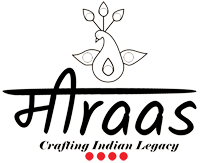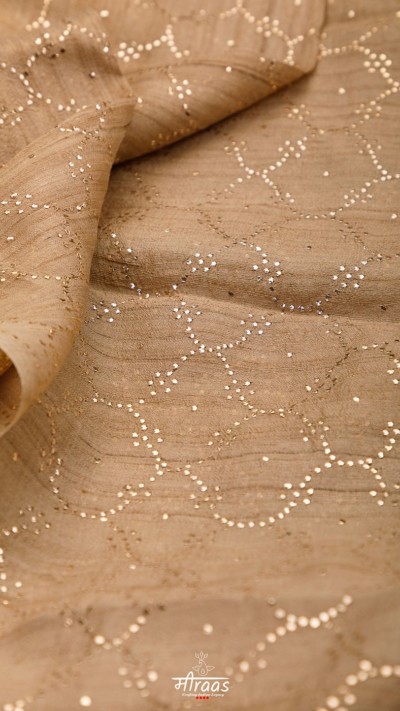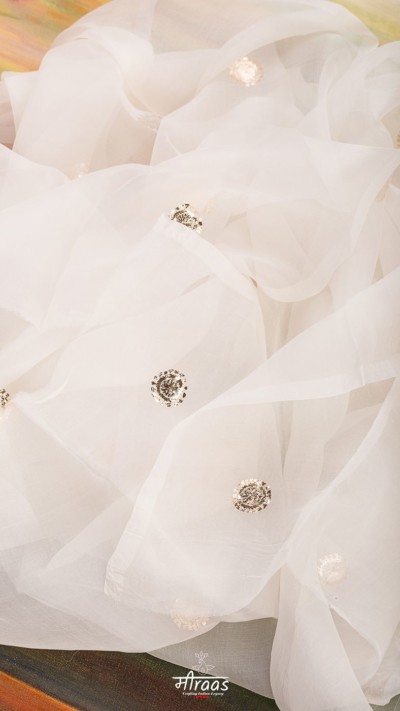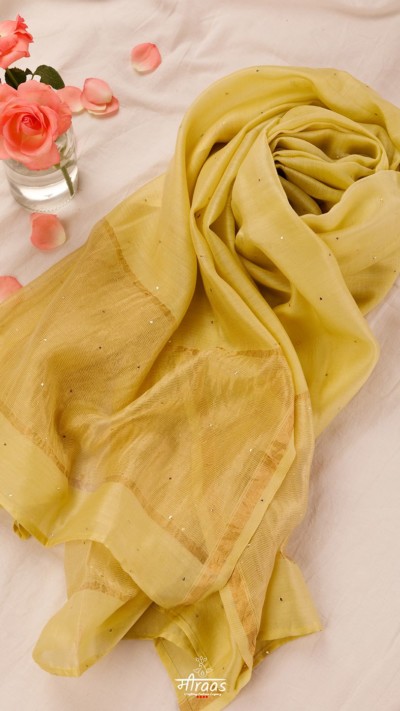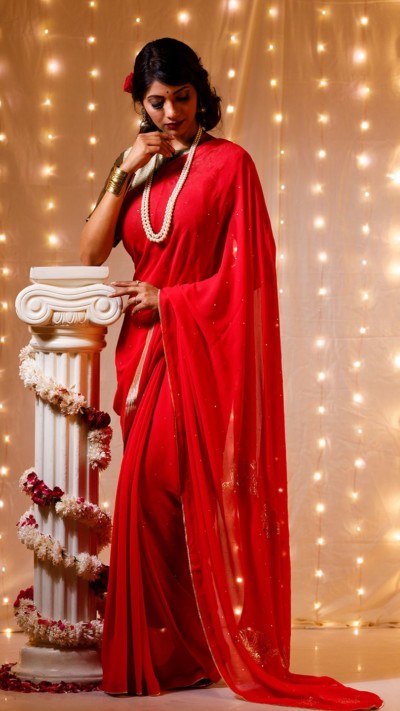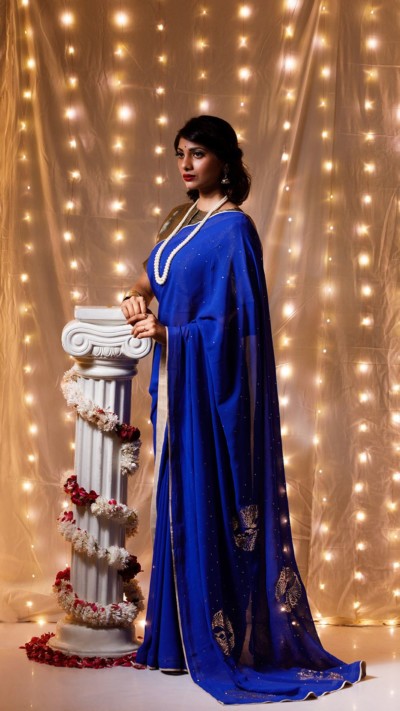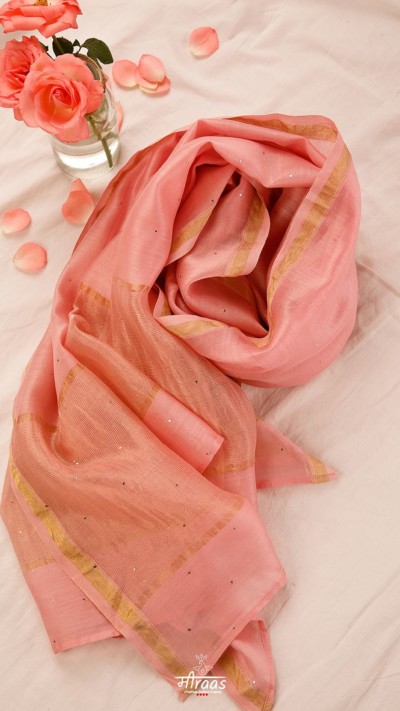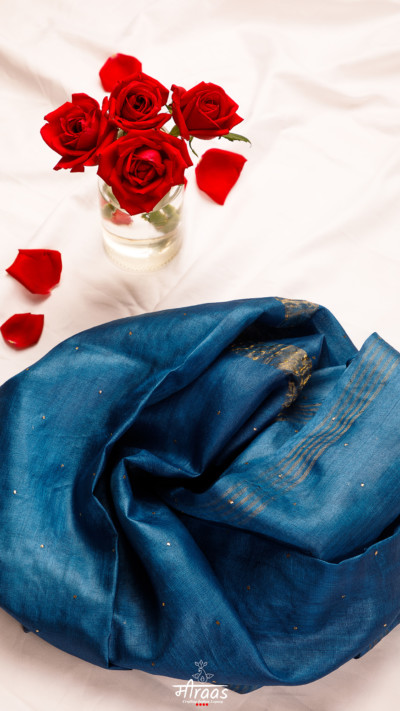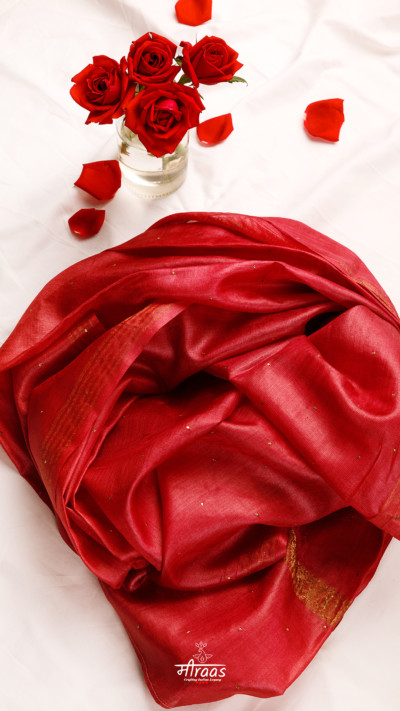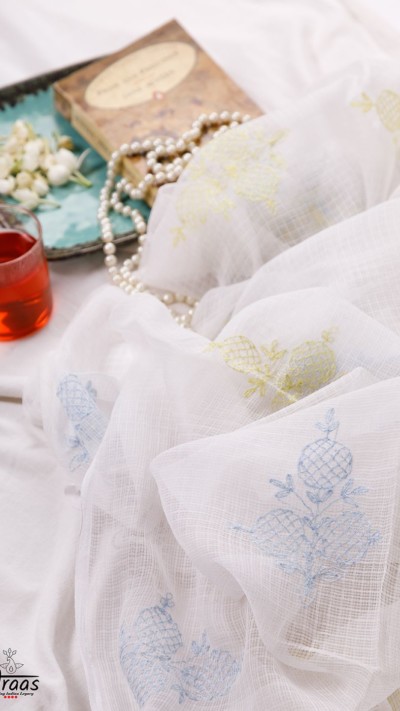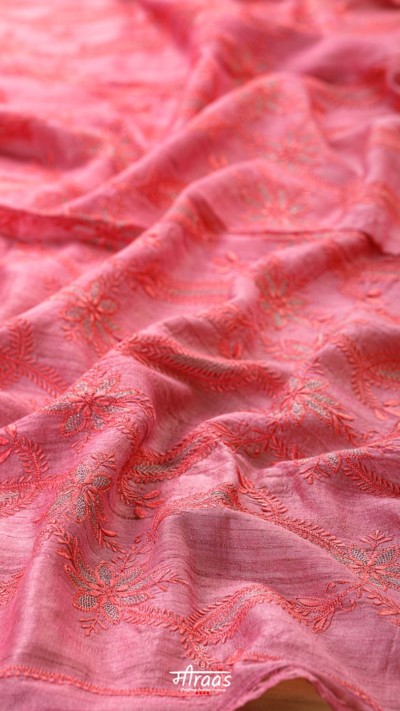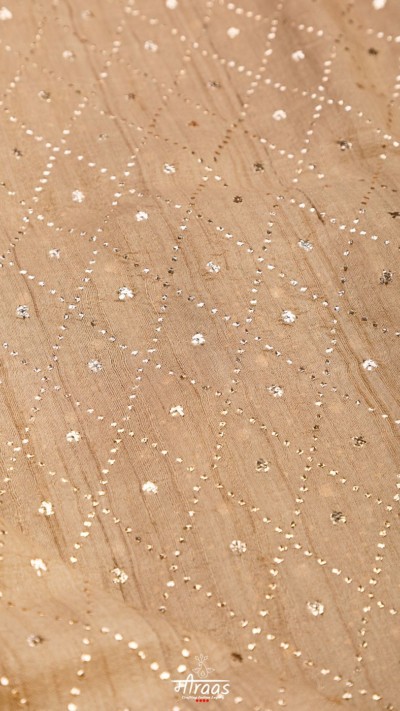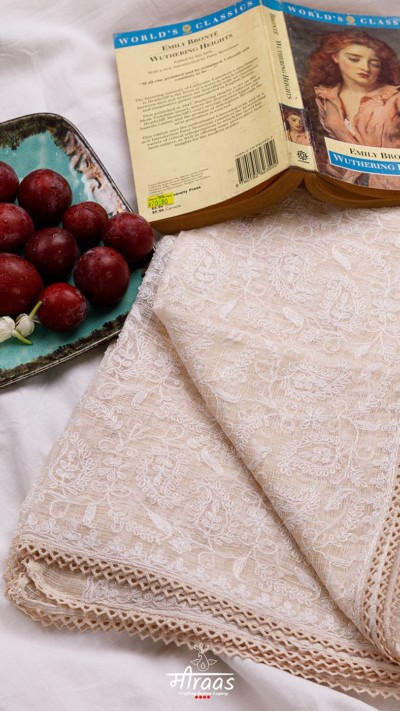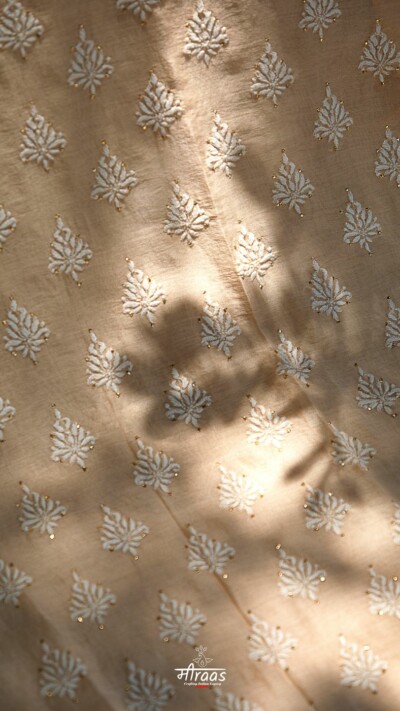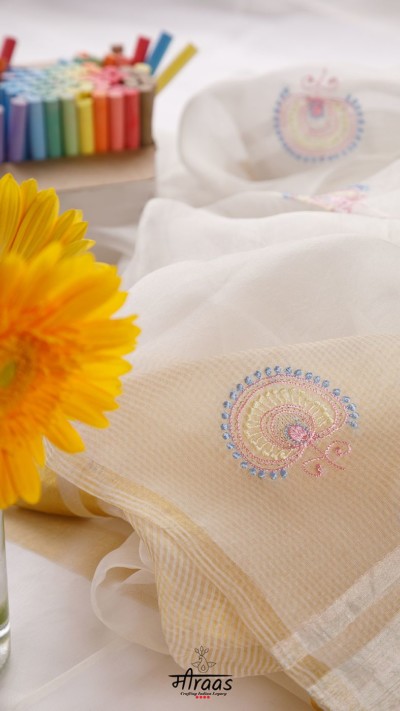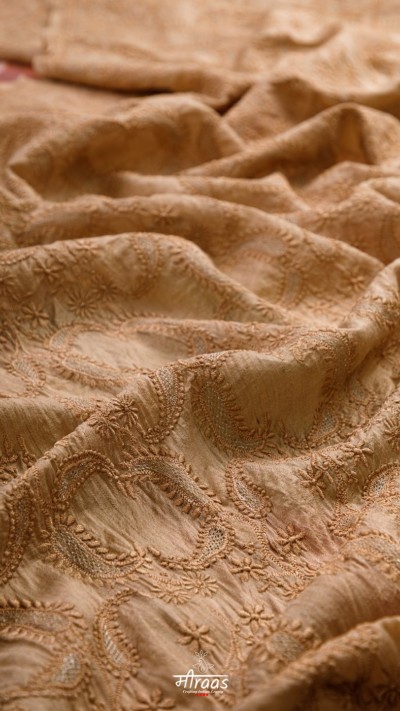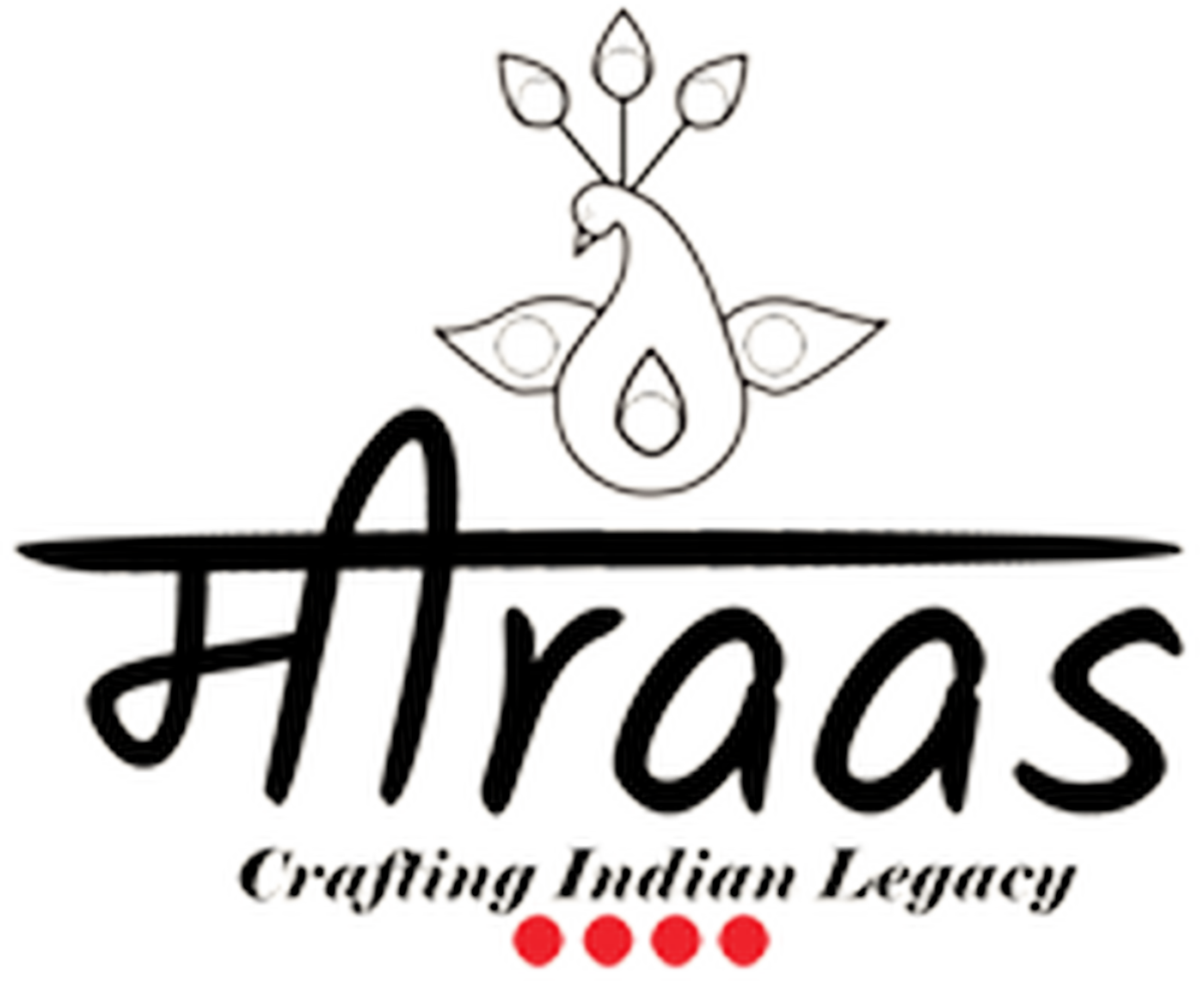
Please, enable Wishlist.
- Home
- Shop
- Dhanlakshami Chikankari Saree
- Advait Mens’ Chikankari
- Power Of Silence (Chikankari Kurta Edit)
- Ready To Ship
- Aari Zardozi
- Luxury Chikankari Dupattas
- The Wedding Collective
- Chikankari Statement Blouses
- Umrao Mukaish Collection
- Dopehri Chikankari Casuals
- Rajnigandha
- Rang Deenhi Shibori Collection
- Curated By Meiraas
- Saree
- Kurta
- Dupatta
- Blouse
- Top
- Stole
- Pants
- Handloom Chanderi
- Handloom Maheshwari
- Handloom Linen
- Handloom Cotton
- Handloom Organza
- Handloom Silk
- Cotton Silk
- Blog
- About
- Sustainability
Trellis Pattern Mukaish Heirloom Full Jaal Tussar Silk Dupatta
₹16,500.00
Golden Trellis is our heirloom collection of Mukaish work that was historically done once upon a time in Awadh region, but is not done any more. Golden Trellis is a result of, one of the many research projects we are working upon simultaneously. We know some might not see light of the day (although we firmly believe that everything can be revived if we just have the right patience and the will to keep going), some will prove to be false tales - a mirage of a narrative built for dramatic value and nothing more...but some, like Golden Trellis will be a reality that can be translated to fabric yet again, even if in a small way, even if a shadow of its one time glory...at least there will be a start.
Golden Trellis is part of the Art & Antiquities Project undertaken by Meiraas.
The Sustainability Quotient (TSQ):
Read more
- Heirloom Full Jaal Mukaish: While Mukaish as a craft has mostly now become an embellishment to Chikankari, we at Meiraas have been trying consistently, to introduce this beautiful craft in all its individual glory, & in more heritage yet functional ways to wear it, to increase the longevity and heirloom value of each piece. Mukaish Jaal Dupattas on Silk are stand alone Heirloom Dupattas, that are versatile to be paired with any Kurta.
- Mukaish Hand Embroidery with proper "ghutaai" - this means Mukaish embroidery has been rubbed using old technique of filling pebbles in a bottle and rubbing on the embroidery, instead of new age roller press method. This one method ensures long lasting Mukaish. In itself Mukaish is more sustainable craft that sequins or "salma sitaara" embroidery, as Mukaish never comes off, maintaing the look of the garment for much longer time.
- Handspun Handwoven Tussar Silk: Thigh reeled, Handspun, Handwoven soft Tussar Silk from the looms of Bhagalpur, Bihar has been used as a base for these dupattas.
Golden Trellis Mukaish Swarna Chakra Organza Dupatta
₹10,500.00
Golden Trellis is our heirloom collection of Mukaish work that was historically done once upon a time in Awadh region, but is not done any more. Golden Trellis is a result of, one of the many research projects we are working upon simultaneously. We know some might not see light of the day (although we firmly believe that everything can be revived if we just have the right patience and the will to keep going), some will prove to be false tales - a mirage of a narrative built for dramatic value and nothing more...but some, like Golden Trellis will be a reality that can be translated to fabric yet again, even if in a small way, or a shadow of its one time glory...at least there will be a start.
Golden Trellis is part of the Art & Antiquities Project undertaken by Meiraas.
The Sustainability Quotient (TSQ):
Read more
- Heritage Mukaish work re created: This work comes under Kamdani Embroidery. The name we have given to this particular style is "glasswork", after we got our Amer saree designed in same stitch. This is due to the fact, that we get it especially rubbed in ghutaai process to get the metal wires to shine like molten glass (we wanted the molten glass painting look of Amer Fort art). This is extremely dexterous work and is done on miniature motif style to ensure its wearability on multiple occasions, instead of it being relegated for very few. This work was historically done in Lucknow. What can be better sustainability than finding out a lost artwork in a craft & helping revive it again to wearable pieces, & most importantly in pieces that can be part of today's Heritage Builders' private collection; this will ensure the craft's continued sustainability.
- Mukaish Hand Embroidery with proper "ghutaai" - this means Mukaish embroidery has been rubbed using old technique of filling pebbles in a bottle and rubbing on the embroidery, instead of new age roller press method. This one method ensures long lasting Mukaish. In itself Mukaish is more sustainable craft that sequins or "salma sitaara" embroidery, as Mukaish never comes off, maintaining the look of the garment for much longer time.
Dhaani
₹2,600.00
The Sustainability Quotient (TSQ):
Read more
- Mukaish Hand Embroidery with proper "ghutaai" - this means Mukaish embroidery has been rubbed using old technique of filling pebbles in a bottle and rubbing on the embroidery, instead of new age roller press method. This one method ensures long lasting Mukaish. In itself Mukaish is more sustainable craft that sequins or "salma sitaara" embroidery, as Mukaish never comes off, maintaing the look of the garment for much longer time.
- Handloom Chanderi Dupatta woven in Chanderi, MP.
- Azo Free, thrice filtered, dye
MADHUBALA | Coral Red Pure Georgette Mukaish Embroidery Saree
₹21,500.00
Reminiscent of the Bollywood divas of 1950s, the sarees in this collection aim at re living that timeless & elegant era, that is so close to the timelessness of Mukaish Embroidery. This Blazing Red Saree is adorned with delicate embroidery of Flight of Pigeons (original Meiraas motif) on palla in a triangle flight pattern, while rest of the saree is covered with stars of Mukaish. A Gold tissue facing gives the much needed finish to this beautiful saree.
Read more
WAHEEDA | Amethyst Coloured Pure Georgette Mukaish Embroidery Saree
₹21,500.00
Reminiscent of the Bollywood divas of 1950s, the sarees in this collection aim at re living that timeless & elegant era, that is so close to the timelessness of Mukaish Embroidery. This Amethyst coloured Saree is adorned with delicate embroidery of Dancing Cranes (original Meiraas motif) on palla in a triangle flight pattern, while rest of the saree is covered with stars of Mukaish. A Gold tissue facing gives the much needed finish to this beautiful saree.
Read more
NARGIS | Royal Blue Pure Georgette Mukaish Embroidery Saree
₹21,500.00
Reminiscent of the Bollywood divas of 1950s, the sarees in this collection aim at re living that timeless & elegant era, that is so close to the timelessness of Mukaish Embroidery. This Royal Blue Saree is adorned with delicate embroidery of Dancing Cranes (original Meiraas motif) on palla in a triangle flight pattern, while rest of the saree is covered with stars of Mukaish. A Gold tissue facing gives the much needed finish to this beautiful saree.
Read more
Basanti
₹2,600.00
The Sustainability Quotient (TSQ):
Read more
- Mukaish Hand Embroidery with proper "ghutaai" - this means Mukaish embroidery has been rubbed using old technique of filling pebbles in a bottle and rubbing on the embroidery, instead of new age roller press method. This one method ensures long lasting Mukaish. In itself Mukaish is more sustainable craft that sequins or "salma sitaara" embroidery, as Mukaish never comes off, maintaing the look of the garment for much longer time.
- Handloom Chanderi Dupatta woven in Chanderi, MP.
- Azo Free, thrice filtered, dye
Gulaabi
₹2,600.00
The Sustainability Quotient (TSQ):
Read more
- Mukaish Hand Embroidery with proper "ghutaai" - this means Mukaish embroidery has been rubbed using old technique of filling pebbles in a bottle and rubbing on the embroidery, instead of new age roller press method. This one method ensures long lasting Mukaish. In itself Mukaish is more sustainable craft that sequins or "salma sitaara" embroidery, as Mukaish never comes off, maintaing the look of the garment for much longer time.
- Handloom Chanderi Dupatta woven in Chanderi, MP.
- Azo Free, thrice filtered, dye
Phalsai
₹2,600.00
The Sustainability Quotient (TSQ):
Read more
- Mukaish Hand Embroidery with proper "ghutaai" - this means Mukaish embroidery has been rubbed using old technique of filling pebbles in a bottle and rubbing on the embroidery, instead of new age roller press method. This one method ensures long lasting Mukaish. In itself Mukaish is more sustainable craft that sequins or "salma sitaara" embroidery, as Mukaish never comes off, maintaing the look of the garment for much longer time.
- Handloom Chanderi Dupatta woven in Chanderi, MP.
- Azo Free, thrice filtered, dye
Sindoori
₹2,200.00
The Sustainability Quotient (TSQ):
Read more
- Mukaish Hand Embroidery with proper "ghutaai" - this means Mukaish embroidery has been rubbed using old technique of filling pebbles in a bottle and rubbing on the embroidery, instead of new age roller press method. This one method ensures long lasting Mukaish. In itself Mukaish is more sustainable craft that sequins or "salma sitaara" embroidery, as Mukaish never comes off, maintaing the look of the garment for much longer time.
- Azo Free, thrice filtered, dye
Blue Sapphire
₹4,900.00
The Sustainability Quotient (TSQ):
Read more
- Mukaish Hand Embroidery with proper "ghutaai" - this means Mukaish embroidery has been rubbed using old technique of filling pebbles in a bottle and rubbing on the embroidery, instead of new age roller press method. This one method ensures long lasting Mukaish. In itself Mukaish is more sustainable craft that sequins or "salma sitaara" embroidery, as Mukaish never comes off, maintaing the look of the garment for much longer time.
- Handloom Tussar Silk woven in Bhagalpur.
- Azo Free, thrice filtered, dye
- Colours like Red, Green, Blue tend to look different in different lights, that is the nature of some colours.
- Colours may vary a bit, although they are all shot professionally in studio set up & closest colour has been photographed; Any variation can be due to digital medium of photography that is outside our control.
Ruby
₹4,900.00
The Sustainability Quotient (TSQ):
Read more
- Mukaish Hand Embroidery with proper "ghutaai" - this means Mukaish embroidery has been rubbed using old technique of filling pebbles in a bottle and rubbing on the embroidery, instead of new age roller press method. This one method ensures long lasting Mukaish. In itself Mukaish is more sustainable craft that sequins or "salma sitaara" embroidery, as Mukaish never comes off, maintaing the look of the garment for much longer time.
- Handloom Tussar Silk woven in Bhagalpur.
- Azo Free, thrice filtered, dye
- Colours like Red, Green, Blue tend to look different in different lights, that is the nature of some colours.
- Colours may vary a bit, although they are all shot professionally in studio set up & closest colour has been photographed; Any variation can be due to digital medium of photography that is outside our control.
